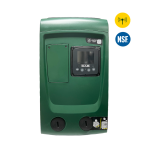Introduction to Water System
A well-designed water system requires a properly sized pressure tank to maintain stable water pressure and prevent damage to the well pump. The pressure tank stores water and air to regulate pressure and protect the well pump from damage, ensuring a reliable plumbing system. Understanding how pressure tanks work is crucial in determining the right size and type for your water system needs, including the pressure switch and air pressure. A pressure gauge is used to measure the tank’s air pressure, and the pressure switch setting is critical in controlling the pump’s operation.
Understanding Pressure Switch
The pressure switch is a critical component that controls the well pump’s operation, turning it on and off based on the pressure in the tank. The pressure switch setting determines when the pump turns on (cut-in pressure) and off (cut-off pressure), typically set between 30-50 psi, 40-60 psi, and 50-70 psi. A properly set pressure switch ensures the pump runs efficiently and prevents damage from short cycling, which can lead to leaks, rust, and wear and tear. The pressure switch is connected to the pressure tank and the well pump, forming a vital part of the plumbing system.
Factors Affecting Water System Performance
Household water demand, well yield, and desired pressure range are key factors that affect the performance of your water system, including the pressure tank and well pump. The number of faucets, showers, and appliances in use simultaneously impacts the water demand, requiring a larger pressure tank to meet the needs. Well yield and recovery rate also play a crucial role in determining the right size pressure tank, as a low-yield well may require a larger tank to compensate. The pressure needed to supply water to all fixtures and appliances must be considered when sizing the pressure tank, taking into account the pressure switch setting.
Sizing Your Well Tank
Correctly sizing your well tank is essential to prevent short cycling, reduce wear and tear on the well pump, and maintain stable water pressure. The tank size depends on the pump flow rate, runtime, and system pressure settings, including the pressure switch setting and air pressure. A minimum runtime of 1-2 minutes is recommended to prevent short cycling, and the tank size should be matched to the pump flow rate to ensure efficient operation. Using a tank size chart or calculator can help determine the right size pressure tank for your water system needs.
Maintaining Your Water System
Regular maintenance is crucial to extend the life of your water system, including the pressure tank, well pump, and plumbing system. Checking the air pressure in the tank annually and inspecting for leaks, rust, and sediment buildup can help prevent damage and ensure efficient operation. Flushing sediment periodically and monitoring pump cycling frequency can also help maintain the system, preventing blocked faucets and appliances. Proper maintenance can help prevent access denied errors and ensure the system runs smoothly, without requiring permission to access restricted areas.
Benefits of Proper System Design
A properly designed water system with a correctly sized pressure tank can provide numerous benefits, including stable water pressure, reduced energy consumption, and extended equipment life.The system can also prevent damage from short cycling, leaks, and corrosion, reducing the need for costly repairs and replacements.A well-designed system can also improve water quality, reduce sediment and rust, and provide a reliable supply of water to all fixtures and appliances. Proper system design can also help prevent errors.
Types of Pressure Tanks
There are various types of pressure tanks available, including diaphragm, bladder, and air-volume control tanks, each with its own advantages and disadvantages. The type of tank suitable for your water system depends on factors like water demand, well yield, and desired pressure range, including the pressure switch setting. Most tanks, like the Amtrol Well-X-Trol, feature advanced engineering and a pre-pressurized design for reliable performance and durability. When selecting a pressure tank, it’s essential to consider factors like size, material, and compatibility with your existing system, including the well pump and plumbing system.
Conclusion and Recommendations
Choosing the right pressure tank for your water system needs is crucial to ensure stable water pressure, prevent damage, and extend equipment life, including the well pump and plumbing system. By considering factors like household water demand, well yield, and desired pressure range, you can select a tank that meets your needs and provides reliable performance. Regular maintenance and proper system design can also help extend the life of your water system and prevent costly repairs, including leaks, rust, and wear and tear. When it comes to water pressure tanks, big is better, it might cost a little more up front but it pays off big in the life cycle of the system. Larger tanks provide fewer pump starts and stops, the longer the run time for the pump will enhance service life immensely, pumps start with higher AMPs which get charged at a higher rate. If you live in an area with frequent power failures it is recommended to have a larger storage tank. This would equate to a larger water supply lasting longer, another added benefit is that some of this water would be heated naturally from the ambient tempatures in contrast to the cooler temps from water still in the ground.




Validate your login